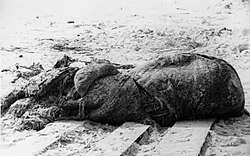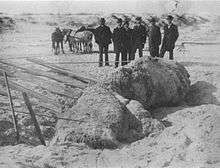Globster

A globster or blob is an unidentified organic mass that washes up on the shoreline of an ocean or other body of water. A globster is distinguished from a normal beached carcass by being hard to identify, at least by initial untrained observers, and by creating controversy as to its identity.
History
The term "globster" was coined by Ivan T. Sanderson in 1962[1] to describe the Tasmanian carcass of 1960, which was said to have "no visible eyes, no defined head, and no apparent bone structure." Other sources simply use the term "blob".
Globsters may present such a puzzling appearance that their nature remains controversial even after being officially identified by scientists. Some globsters lack bones or other recognisable structures, while others may have bones, tentacles, flippers, eyes, or other features that can help narrow down the possible species. In the past, these were often described as sea monsters, and myths and legends about such monsters may often have started with the appearance of a globster.
Many globsters have initially been described as gigantic octopuses, though they later turned out to be decayed carcasses of whales or large sharks. As with the "Chilean Blob" of 2003, many are masses of whale blubber released from decaying whale corpses. Others initially thought to be dead plesiosaurs later turned out to be the decayed carcases of basking sharks. Others remain unexplained. Giant and colossal squid may also explain some globsters, particularly those tentatively identified as monster octopuses.
Some globsters were examined only after they had decomposed too much and seemed to represent evidence of a new species, or were destroyed—as happened with the "Cadborosaurus willsi" carcass, found in 1937.[2] However, Canadian scientists did analyse the DNA of the Newfoundland Blob—which revealed that the tissue was from a sperm whale. In their resulting paper, the authors point out a number of superficial similarities between the Newfoundland Blob and other globsters, concluding a similar origin for those globsters is likely.[3] Analyses of other globsters have yielded similar results.[4][5]
Notable globsters

The following is a chronological list of carcasses that have been described as globsters or blobs in the literature.[1][6][7]
- Stronsay Beast (1808)
- St. Augustine Monster (1896) - Identified as a whale carcass.[4]
- Trunko (1924)
- Tasmanian Globster (1960) - Identified as a whale carcass.[8]
- New Zealand Globster (1965) - Identified as a whale carcass.[9]
- Tasmanian Globster 2 (1970)
- Gambo (1983)
- Bermuda Blob (1988) - Identified as a whale carcass.[5]
- Hebrides Blob (1990) - Identified as a sperm whale carcass.[10]
- Nantucket Blob (1996) - Identified as a whale carcass.[5]
- Bermuda Blob 2 (1997) - Identified as a whale carcass.[5]
- Four Mile Globster (1997)
- Newfoundland Blob (2001) - Identified as a whale carcass.[11]
- Chilean Blob (2003) - Identified as a whale carcass.[5]
- Philippine Globster (2017)[12]
- Seram Island 'squid' (9 May 2017)[13][14]
- Philippine Globster II (2018)[15]
- Russia Globster (2018 aug 15)[16]
See also
References
- 1 2 Newton, Michael (2009). Hidden Animals: A Field Guide to Batsquatch, Chupacabra, and Other Elusive Creatures. ABC-CLIO/Greenwood. pp. 79–81. ISBN 978-0-313-35906-4.
- ↑ Bousfield, Edward L. & Leblond Paul H. (2000). Cadborosaurus: Survivor from the Deep. Heritage House Publishing.
- ↑ Carr, S.M., H.D. Marshall, K.A. Johnstone, L.M. Pynn & G.B. Stenson 2002. How to tell a sea monster: molecular discrimination of large marine animals of the North Atlantic. Biological Bulletin 202: 1–5.
- 1 2 Pierce, S., G. Smith, T. Maugel & E. Clark 1995. On the Giant Octopus (Octopus giganteus) and the Bermuda Blob: homage to A. E. Verrill. Biological Bulletin 188: 219–230.
- 1 2 3 4 5 Pierce, S., S. Massey, N. Curtis, G. Smith, C. Olavarría & T. Maugel 2004. Microscopic, biochemical, and molecular characteristics of the Chilean Blob and a comparison with the remains of other sea monsters: nothing but whales. Biological Bulletin 206: 125–133.
- ↑ Ellis, R. 1994. Monsters of the Sea. Robert Hale, London.
- ↑ Puig, R. 2004. A Whale of a Tale. Research Online, University of South Florida.
- ↑ Harris, J.M. 2005 "Mammal Records from the Tasmanian Naturalist" (PDF). Archived from the original (PDF) on 2009-09-12. The Tasmanian Naturalist 127: 20-41
- ↑ "'Whale' of a mystery is solved". Auckland Star. 24 March 1965. p. 1.
- ↑ Carr, S.M., H.D. Marshall, K.A. Johnstone, L.M. Pynn & G.B. Stenson 2002. How To Tell a Sea Monster: Molecular Discrimination of Large Marine Animals of the North Atlantic.] Biological Bulletin 202: 1-5.
- ↑ Carr, S.M., H.D. Marshall, K.A. Johnstone, L.M. Pynn & G.B. Stenson 2002. How to tell a sea monster: molecular discrimination of large marine animals of the North Atlantic. Biological Bulletin 202: 1–5.
- ↑ Gibbens, Sarah (February 27, 2017). "Mysterious "Hairy Blob" Washed Up on Philippines Beach". National Geographic News. Retrieved 28 February 2017.
- ↑ "'Giant Squid' That Washed Up on Seram Island Was a Whale: Officials". Jakarta Globe. 13 May 2017. Retrieved 13 May 2017.
- ↑ Cumi-cumi Raksasa di Pulau Seram [Giant Squid on Seram Island] (in Indonesian). 10 May 2017. Retrieved 13 May 2017.
- ↑ http://www.dailymail.co.uk/news/article-5720911/Massive-mysterious-globster-sea-creature-washes-beach-Philippines.html
- ↑ "Mysterious furry sea 'monster' washes up on beach". New York Post. 16 August 2018.
Further reading
- Clark, Jerome and Coleman, Loren. (1999). Cryptozoology A-Z. Simon & Schuster.